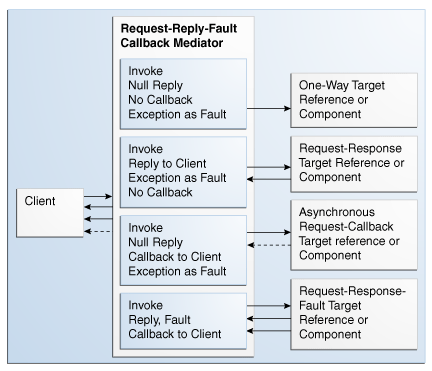Request-Reply-Fault-Callback Message Exchange Patterns
In a request-reply-fault-callback interaction, the Mediator is invoked and sends a response, an asynchronous reply, and one or more fault types to the initial caller. Depending on the type of routing rule target, the responses, faults, and callbacks are handled as shown in Table 24-7:
Table 24-7 Response to a Request Response Fault Callback Mediator
| WSDL of the Routing Rule Target | Response |
|---|---|
|
Request |
There should be at least one sequential routing rule with a request-callback service and at least one sequential routing rule that returns a response. No callback or response is sent unless the required routing rules are defined. |
|
Request Response |
There should be at least one sequential routing rule with a request-callback service and at least one sequential routing rule that returns a response. No callback or response is sent unless the required routing rules are defined. |
|
Request Response Fault |
There should be at least one sequential routing rule with a request-callback service and at least one sequential routing rule that returns a response. No callback or response is sent unless the required routing rules are defined. |
|
Request Callback |
There should be at least one sequential routing rule that returns a response. Mediator returns |
|
Request Response Callback |
The response and callback are sent back to the caller. Any exception in Mediator message processing may result in a fault. |
|
Request Response Fault Callback |
The response, fault, and callback are sent back to the caller. |
Figure 24-6 illustrates the request-reply-fault-callback message exchange pattern.
Figure 24-6 Request-Reply-Fault-Callback Message Exchange Pattern

Description of "Figure 24-6 Request-Reply-Fault-Callback Message Exchange Pattern"